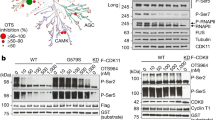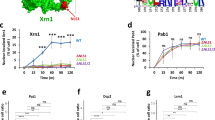Abstract
Genetic studies have shown that CDC5 proteins are essential for G2 progression and mitotic entry. CDC5 homologs in yeast and mammals are essential for pre-messenger ribonucleic acid (mRNA) processing. Other gene products also have been shown to play roles in both pre-mRNA splicing and cell cycle regulation, prompting the description of several models to explain the mechanism(s) linking these two processes. In this study, we demonstrate that the amino-terminus of human CDC5 directs nuclear import independent of consensus nuclear localization signals or phosphorylation, and that the carboxyl-terminus of human CDC5 preferentially associates with spliceosomal complexes in proximity of RNA transcription during interphase. hCDC5 colocalizes with Sm proteins in a cell cycle- and domain-dependent manner, and several proteins in the human CDC5-associated complex are identified that suggest potential roles for the complex in coupling pre-mRNA splicing to transcriptional activation and protein translation. These results indicate that human CDC5 may function in pre-mRNA processing and cell cycle progression through more than one mechanism.
Similar content being viewed by others
References
Nasmyth, K. and Nurse, P. (1981) Cell division cycle mutants altered in DNA replication and mitosis in the fission yeast Schizosaccharomyces pombe. Mol. Gen. Genet. 182, 119–124.
Ohi, R., McCollum, D., Hirani, B., Den Haese, G. J., Zhang, X., Burke, J. D., Turner, K. and Gould, K. L. (1994) The Schizosaccharomyces pombe cdc5+gene encodes an essential protein with homology to c-Myb. EMBO J. 13, 471–483.
Bernstein, H. S. and Coughlin, S. R. (1998) A mammalian homolog of fission yeast Cdc5 regulates G2 progression and mitotic entry. J. Biol. Chem. 273, 4666–4671.
Bernstein, H. S. and Coughlin, S. R. (1997) Pombe Cdc5-related protein. A putative human transcription factor implicated in mitogen-activated signaling. J. Biol. Chem. 272, 5833–5837.
Lei, X.-H., Shen, X., Xu, X.-Q. and Bernstein, H. S. (2000) Human Cdc5, a regulator of mitotic entry, can act as a site-specific DNA binding protein. J. Cell. Sci. 113, 4523–4531.
Johnson, L. M. and Too, C. K. (2001) Prolactin, interleukin-2 and FGF-2 stimulate expression, nuclear distribution and DNA-binding of rat homolog of pombe Cdc5 in Nb2 T lymphoma cells. Mol. Cell. Endocrinol. 184, 151–161.
Tsai, W. Y., Chow, Y. T., Chen, H. R., Huang, K. T., Hong, R. I., Jan, S. P., et al. (1999) Cef1p is a component of the Prp 19p-associated complex and essential for pre-mRNA splicing. J. Biol. Chem. 274, 9455–9462.
McDonald, W. H., Ohi, R., Smelkova, N., Frendewey, D. and Gould, K. L. (1999) Mybrelated fission yeast cdc5p is a component of a 40S snRNP-containing complex and is essential for pre-mRNA splicing. Mol. Cell. Biol. 19, 5352–5362.
Ajuh, P., Kuster, B., Panov, K., Zomerdijk, J. C., Mann, M. and Lamond, A. I. (2000) Functional analysis of the human CDC5L complex and identification of its components by mass spectrometry. EMBO. J. 19, 6569–6581.
Ohi, M. D., Link, A. J., Ren, L., Jennings, J. L., McDonald, W. H. and Gould, K. L. (2002) Proteomics analysis reveals stable multiprotein complexes in both fission and budding yeasts containing Myb-related Cdc5p/Cef1p, novel pre-mRNA splicing factors, and snRNAs. Mol. Cell. Biol. 22, 2011–2024.
Zhou, Z., Licklider, L. J., Gygi, S. P. and Reed, R. (2002) comprehensive proteomic analysis of the human spliceosome. Nature 419, 182–185.
Makarov, E. M., Makarova, O. V., Urlaub, H., Gentzel, M., Will, C. L., Wilm, M. and Luhrmann, R. (2002) Small nuclear ribonucleo-protein remodeling during catalytic activation of the spliceosome. Science 298, 2205–2208.
Burns, C. G., Ohi, R., Krainer, A. R. and Gould, K. L. (1999) Evidence that Myb-related CDC5 proteins are required for pre-mRNA splicing. Proc. Natl. Acad. Sci. USA 96, 13789–13794.
Boudrez, A., Beullens, M., Groenen, P., Van Eynde, A., Vulsteke, V., Jagiello, I., et al. (2000) NIPP1-mediated interaction of protein phosphatase-1 with CDC5L, a regulator of pre-mRNA splicing and mitotic entry. J. Biol. Chem. 275, 25411–25417.
Ajuh, P., Sleeman, J., Chusainow, J. and Lamond, A. I. (2001) A direct interaction between the carboxyl-terminal region of CDC5L and the WD40 domain of PLRG1 is essential for pre-mRNA splicing. J. Biol. Chem. 276, 42370–42381.
Burns, C. G., Ohi, R., Mehta, S., O'Toole, E. T., Winey, M., Clark, et al. (2002) Removal of a single alpha-tubulin gene intron suppresses cell cycle arrest phenotypes of splicing factor mutations in Saccharomyces cerevisiae. Mol. Cell. Biol. 22, 801–815.
Morgan, D. O. (1997) Cyclin-dependent kinases: engines, clocks, and microprocessors. Ann. Rev. Cell Dev. Biol. 13, 261–291.
Johnston, L. H. and Thomas, A. P. (1982) The isolation of new DNA synthesis mutants in the yeast Saccharomyces cerevisiae. Mol. Gen. Genet. 186, 439–444.
Vijayraghavan, U., Company, M. and Abelson, J. (1989) Isolation and characterization of pre-mRNA splicing mutants of Saccharomyces cerevisiae. Genes Dev. 3, 1206–1216.
Shea, J. E., Toyn, J. H. and Johnston, L. H. (1994) The budding yeast U5 snRNP Prp8 is a highly conserved protein which links RNA splicing with cell cycle progression. Nuclo Acids Res. 22, 5555–5564.
Kassir, Y. and Simchen, G. (1978) Meiotic recombination and DNA synthesis in a new cell cycle mutant of Saccharomyces cerevisiae. Genetics 90, 49–68.
Kassir, Y., Kupiec, M., Shalom, A. and Simchen, G. (1985) Cloning and mapping of CDC40, a Saccharomyces cerevisiae gene with a role in DNA repair. Curr. Genet. 9, 253–257.
Kupiec, M. and Simchen, G. (1986) DNA-repair characterization of cdc40-1, a cell-cycle mutant of Saccharomyces cerevisiae. Mutat. Res. 162, 33–40.
Vaisman, N., Tsouladze, A., Robzyk, K., Ben-Yehuda, S., Kupiec, M. and Kassir, Y. (1995) The role of Saccharomyces cerevisiae Cdc40p in DNA replication and mitotic spindle formation and/or maintenance. Mol. Gen. Genet. 247, 123–136.
Hwang, L. H. and Murray, A. W. (1997) A novel yeast screen for mitotic arrest mutants identifies DOC1, a new gene involved in cyclin proteolysis. Mol. Biol. Cell. 8, 1877–1887.
Company, M., Arenas, J. and Abelson, J. (1991) Requirement of the RNA helicase-like protein PRP22 for release of messenger RNA from spliceosomes. Nature 349, 487–493.
Lundgren, K., Allan, S., Urushiyama, S., Tani, T., Ohshima, Y., Frendewey, D. and Beach, D. (1996) A connection between pre-mRNA splicing and the cell cycle in fission yeast: cdc28+ is allelic with prp8+ and encodes an RNA-dependent ATPase/helicase. Mol. Biol. Cell. 7, 1083–1094.
Potashkin, J., Naik, K. and Wentz-Hunter, K. (1993) U2AF homolog required for splicing in vivo. Science 262, 573–575.
Takahashi, K., Yamada, H. and Yanagida, M. (1994) Fission yeast minichromosome loss mutants mis cause lethal aneuploidy and replication abnormality. Mol. Biol. Cell. 5, 1145–1158.
Gross, T., Richert, K., Mierke, C., Lutzelberger, M. and Kaufer, N. F. (1998) Identification and characterization of srpl, a gene of fission yeast encoding a RNA binding domain and a RS domain typical of SR splicing factors. Nucl. Acids Res. 26, 505–511.
Rosenberg, G. H., Alahari, S. K. and Kaufer, N. F. (1991) prp4 from Schizosaccharomyces pombe, a mutant deficient in pre-mRNA splicing isolated using genes containing artificial introns. Mol. Gen. Genet. 226, 305–309.
Tang, Z., Yanagida, M. and Lin, R. J. (1998) Fission yeast mitotic regulator Dsk1 is an SR protein-specific kinase. J. Biol. Chem. 273, 5963–5969.
Spector, D. L. (1994) RNA processing. Cycling splicing factors. Nature 369, 604.
Seshadri, V., Vaidya, V. C. and Vijayraghavan, U. (1996) Genetic studies of the PRP17 gene of Saccharomyces cerevisiae: A domain essential for function maps to a nonconserved region of the protein. Genetics 143, 45–55.
Stukenberg, P. T., Lustig, K. D., McGarry, T. J., King, R. W., Kuang, J. and Kirschner, M. W. (1997) Systematic identification of mitotic phosphoproteins. Curr. Biol. 7, 338–348.
Mintz, P. J. and Spector, D. L. (2000) Compartmentalization of RNA processing factors within nuclear speckles. J. Struct. Biol. 129, 241–251.
Dignam, J. D., Lebovitz, R. M. and Roeder, R. G. (1983) Accurate transcription initiation by RNA polymerase II in a soluble extract from isolated mammalian nuclei. Nucl. Acids Res. 11, 1475–1489.
Markovtsov, V., Nikolic, J. M., Goldman, J. A., Turck, C. W., Chou, M. Y. and Black, D. L. (2000) Cooperative assembly of an hnRNP complex induced by a tissue-specific homolog of polypyrimidine tract binding protein. Mol. Cell. Biol. 20, 7463–7479.
Duverger, E., Pellerin-Mendes, C., Mayer, R., Roche, A. C. and Monsigny, M. (1995) Nuclear import of glycoconjugates is distinct from the classical NLS pathway. J. Cell. Sci. 108, 1325–1332.
Shevchenko, A., Wilm, M., Vorm, O. and Mann, M. (1996) Mass spectrometric sequencing of proteins silver-stained polyacrylamide gels. Anal. Chem. 68, 850–858.
Eilbracht, J. and Schmidt-Zachmann, M. S. (2001) Identification of a sequence element directing a protein to nuclear speckles. Proc. Natl. Acad. Sci. USA 98, 3849–3854.
Wei, X., Somanathan, S., Samarabandu, J. and Berezney, R. (1999) Three-dimensional visualization of transcription sites and their association with splicing factor-rich nuclear speckles. J. Cell. Biol. 146, 543–558.
Ohi, R., Reoktistova, A., McCann, S., Valentine, V., Look, A. T., Lipsick, J. S. and Gould, K. L. (1998) Myb-related Schizosaccharomyces pombe cdc5p is structurally and functionally conserved in eukaryotes. Mol. Cell. Biol. 18, 4097–4108.
van der Houven van Oordt, W., Diaz-Meco, M. T., Lozano, J., Krainer, A. R., Moscat, J. and Caceres, J. F. (2000) The MKK(3/6)-p38-signaling cascade alters the subcellular distribution of hnRNP A1 and modulates alternative splicing regulation. J. Cell. Biol. 149, 307–316.
Tollervey, D. and Caceres, J. F. (2000) RNA processing marches on. Cell 103, 703–709.
Engemann, H., Heinzel, V., Page, G., Preuss, U. and Scheidtmann, K. H. (2002) DAP-like kinase interacts with the rat homolog of Schizosaccharomyces pombe CDC5 protein, a factor involved in pre-mRNA splicing and required for G2/M phase transition. Nucl. Acids Res. 30, 1408–1417.
Zhang, D., Abovich, N. and Rosbash, M. (2001) A biochemical function for the Sm complex. Mol. Cell. 7, 319–329.
Venables, J. P., Elliott, D. J., Makarova, O. V., Makarov, E. M., Cooke, H. J. and Eperon, I. C. (2000) RBMY, a probable human spermatogenesis factor, and other hnRNP G proteins interact with Tra2beta and affect splicing. Hum. Mol. Genet. 9, 685–694.
Gotzmann, J., Gerner, C., Meissner, M., Holzmann, K., Grimm, R., Mikulits, W. and Sauermann, G. (2000) hNMP 200: a novel human common nuclear matrix protein combining structural and regulatory functions. Exp. Cell. Res. 261, 166–179.
Sasaki, Y., Itoh, F., Suzuki, H., Kobayashi, T., Kakiuchi, H., Hareyama, M. and Imai, K. (2000) Identification of genes highly expressed in G2-arrested Chinese hamster ovary cells by differential display analysis. J. Clin. Lab. Anal. 14, 314–319.
Serfling, E., Berberich-Siebelt, F., Chuvpilo, S., Jankevics, E., Klein-Hessling, S., Twardzik, T. and Avots, A. (2000) The role of NF-AT transcription factors in T cell activation and differentiation. Biochim. Biophys. Acta 1498, 1–18.
Author information
Authors and Affiliations
Corresponding author
Rights and permissions
About this article
Cite this article
Liu, L., Gräub, R., Hlaing, M. et al. Distinct domains of human CDC5 direct its nuclear import and association with the spliceosome. Cell Biochem Biophys 39, 119–131 (2003). https://doi.org/10.1385/CBB:39:2:119
Issue Date:
DOI: https://doi.org/10.1385/CBB:39:2:119




